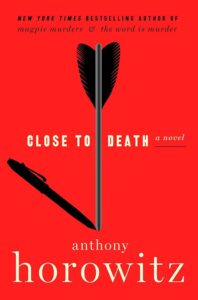Hawthorne & Horowitz #5
 Anthony Horowitz is simply a plotting genius, with a brain that must that must be constantly constructing puzzles, and fortunately for us, he’s nice enough to share a few. His latest gem is an instalment in his very meta Hawthorne and Horowitz series, where Horowitz himself takes the almost Hastings-esque form of a writer who follows genius detective Hawthorne around, writing down his actions, thus creating the novel we hold in our hands. As this outing begins Horowitz is working on a new book under a deadline, but unfortunately Hawthorne hasn’t caught anything interesting for a while. Horowitz decides to revisit an old case, and as Hawthorne doles the story out to him in portions he writes, using case notes as his guide, creating personas for the people involved in the story.
Anthony Horowitz is simply a plotting genius, with a brain that must that must be constantly constructing puzzles, and fortunately for us, he’s nice enough to share a few. His latest gem is an instalment in his very meta Hawthorne and Horowitz series, where Horowitz himself takes the almost Hastings-esque form of a writer who follows genius detective Hawthorne around, writing down his actions, thus creating the novel we hold in our hands. As this outing begins Horowitz is working on a new book under a deadline, but unfortunately Hawthorne hasn’t caught anything interesting for a while. Horowitz decides to revisit an old case, and as Hawthorne doles the story out to him in portions he writes, using case notes as his guide, creating personas for the people involved in the story.
In a very Horowitz fashion, we are introduced to a very golden-age style set up. The most unpopular member of a tight little community (or close) on the edge of the Thames is one Giles Kenworthy, and as the book opens, chess master Adam Strauss loses an online match due to Giles’s late and loud arrival. The doctor who lives next door hates him because they share a driveway, and he sometimes is blocked in and unable to get to work. The two blameless old ladies who own a mystery bookshop are on the warpath because he hates their dog, who, to be fair, gets into their garden and leaves his mark. Other neighbors are in an uproar because Giles is about to build a swimming pool which will obstruct their view, one of the few pleasures of an invalid woman resident, as well as necessitating the cutting down of the magnolia she most treasures. Their roiling mob mentality is held in check by the barrister who lives at the foot of the close, who tells them (weirdly) that legal action is not a solution.
In true Golden Age fashion, there’s even a map of the neighborhood.
Horowitz wisely concentrates on the characters of the neighbors, leaving Giles to the imagination of the reader. Of course, it’s the guy everybody has a motive to kill who is murdered, and when Giles is cut down by a crossbow from one of the garages in the neighborhood, the police descend, questioning everyone. They’re accompanied by Hawthorne, who works, much like Detective Monk, as a private advisor to the police. He deals with the cast of characters in his own way, often several steps ahead of the preening narcissist cop who is running the official investigation, and even has his own second in command, a man named Dudley, who Horowitz is extremely curious about.
When Hawthorne and Horowitz meet to discuss the first chapters (which the reader has also seen) Hawthorne tells Horowitz to give it up – he won’t like how the story ends. Horowitz plows ahead, however, going his own way when Hawthorne becomes reluctant to share more details of the crime.
As this is an Anthony Horowitz novel there’s no small event that isn’t relevant to the plot, and it’s keeping track of all the meaningful clues that’s tricky. When there’s a literal locked room death about three quarters of the way through, the whole story is upended, and much like Horowitz the character, I had no idea where it was heading.
At about this point, Horowitz the character/writer of the book decrees: “The real problem of the locked room mystery is that the mechanics are often so complicated…the emotions of the story can disappear.” I applied this to my reading of this novel which is indeed a locked room mystery, and found that I was moved by the characters, many of whom are hiding secrets from their pasts. More to the point, both the plot and the ultimate solution to the crime credibly emerges from their personalities.
There are revelations and emotions a plenty, as well as an extremely clever ending. While perhaps not as glorious an achievement as Magpie Murders, it’s very, very good. — Robin Agnew